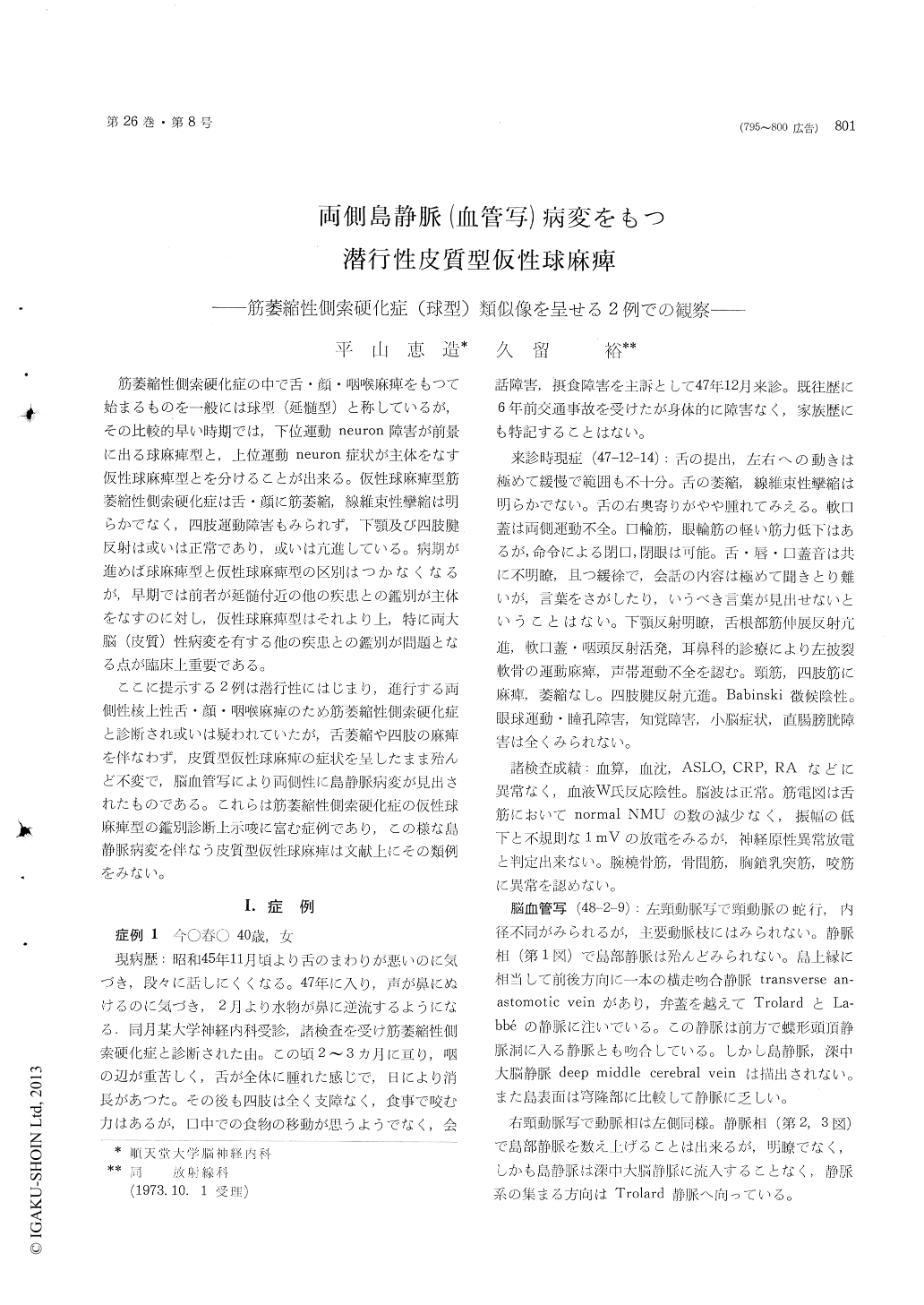Japanese
English
- 有料閲覧
- Abstract 文献概要
- 1ページ目 Look Inside
筋萎縮性側索硬化症の中で舌・顔・咽喉麻痺をもって始まるものを一般には球型(延髄型)と称しているが,その比較的早い時期では,下位運動neuron障害が前景に出る球麻痺型と,上位運動neuron症状が主体をなす仮性球麻痺型とを分けることが出来る。仮性球麻痺型筋萎縮性側索硬化症は舌・顔に筋萎縮,線維束性攣縮は明らかでなく,四肢運動障害もみられず,下顎及び四肢腱反射は或いは正常であり,或いは亢進している。病期が進めば球麻痺型と仮性球麻痺型の区別はつかなくなるが,早期では前者が延髄付近の他の疾患との鑑別が主体をなすのに対し,仮性球麻痺型はそれより上,特に両大脳(皮質)性病変を有する他の疾患との鑑別が問題となる点が臨床上重要である。
ここに提示する2例は潜行性にはじまり,進行する両側性核上性舌・顔・咽喉麻痺のため筋萎縮性側索硬化症と診断され或いは疑われていたが,舌萎縮や四肢の麻痺を伴なわず,皮質型仮性球麻痺の症状を呈したまま殆んど不変で,脳血管写により両側性に島静脈病変が見出されたものである。これらは筋萎縮性側索硬化症の仮性球麻痺型の鑑別診断上示唆に富む症例であり,この様な島静脈病変を伴なう皮質型仮性球麻痺は文献上にその類例をみない。
In earlier stage, the bulbar form of amyotrophic lateral sclerosis (ALS) is divided into two types: (progressive) bulbar palsy type and cortical pseudo-bulbar palsy type. In the former, troubles are pre-dominant in the lower motor neuron. On the contrary, pathology of the upper motor neuron is more in the latter. In two cases reported in this paper, ALS of cortical pseudobulbar palsy type was suspected, because of linguo-labio-pharyngeal paraly-sis of slow progression, but not followed by muscular atrophy. However, their evolution was stationary, after one or one-half years since onset. Carotid angiography revealed the lesion of the bilateral insular veins in both cases.
Case 1. 40-year-old woman. Difficulty in speech (tongue) started from November 1970, disturbanceof swallowing from February 1972. Since then the course was stationary. Neurological examination in December 1972 revealed : marked palsy of the tongue, lips and pharynx, showing dysarthria and dysphagia, without muscular atrophy or fascicula-tion. No other cranial nerve was involved and slight hyperreflexia was found without weakness in the upper and lower extremities and with negative Babinski sign. No sensory impairement, nor cere-bellar symptoms, nor sphincter disturbances did exist. Mental capacity remained normal. Carotid angiogram (9 Feb. 1973) showed no remarkable change in the arteries. On venous phase, scarece insular veins and no deep middle cerebral vein were found on the left side (Fig. 1). The insular veins of the right side were able to be enumerated, but obscure (Fig. 2, 3). The drainage from the in-sular area poured into the Trolard vein.
Case 2. 69-year-old woman. Disturbance of the tongue movement started from March 1970, follow-ed by difficulty of swallowing. Clinical picture was stationary since one year after onset. Clinical pictures, in March 1973, was similar to that of case 1, except normal reflexes in extremities. Carotid angiogram (27 March 1973) showed slight arte-riosclerotic change. On venous phase, no insular veins were shown and many drainagic veins to the Labbe vein were found on the left side (Fig. 4, 5). No drainage system from the insular veins to the deep middle cerebral vein was observed. On the right also, the insular veins were scanty, but the central (insular) vein alone was visible (Fig. 6, 7). The perforating veins ran toward the Labbe vein.
The particularities in semiology of our cases of cortical pseudobulbar palsy were pointed out ; weak-ness was limited on more restricted area than in the classical descriptions (Alajouamine and Thurel, etc.). No dissociation between voluntary movement and automatic reflex movement in the affected muscles, nor atonia was observed in our two cases, which were habitually described in classical cases. The angiographic lesion of the insular veins, ob-servation of which was based on the description recently made by Wolf and Huang (1963), was demonstrated bilaterally in both two cases and no similar cases have been reported.
In literature, we found three clinico-anatomical cases with cortical pseudobulbar palsy (Raymond et al., Tournier, and Alajouanine et al.), in which the bilateral lesions were extended from the external part of the lenticular nucleus to the external capsule, which was just beneath the insular cortex. The possible relation between the cortical pseudobulbar palsy and the bilateral lesions of the insular veins was discussed.

Copyright © 1974, Igaku-Shoin Ltd. All rights reserved.


